
Eve Online | Cosmos Amarr Material Farming

Fallout Shelter is one of those games you can play just a couple of minutes when you are just bored and need to kill some time.
It’s not a very complex game or deep single player game at that. While it is free to play it also has a cash shop. While the game does have some time gates in it that I could see some wanting to spend microtransactions on wanting speeding things up. To me, it was just a game you played for five to ten minutes at a time. You would get your base in shape; send dwellers out to the wastelands and any other chores before closing the game and checking in again later.

A big part of this game is just building up your vault. For that, you had quite a wide range of rooms to select from. They also gave you a really huge underground area you could build in. Every couple of levels you were also unlocking something new.
Many of these rooms required you to assign those living in the vault to them for them to operate. While others they could be used in a limited fashion such as storage or provide some other kind of benefit like being able to go out on missions.

For the rooms that required active dwellers in to operate them, some of them could be rushed to near-instantly get those resources and some in-game money called caps. The drawback is if they failed you would have an event happen. Like a fire or roaches that you would then have to deal with or it would spread to other rooms. Putting your vault into a bit of a panic lockdown until it got resolved.
Thankfully if the game was not acclivity running these things were not occurring. You also did not have to be clicking on resources when you were offline since your vault was not requiring them after a certain point. These things happened during the active element of your gameplay when you log back in to check up on things. Which I really enjoined since I could forget about the game for a week(s) and it did not have an effect on my vault itself.

Another interesting part of trying to manage your vault was picking what room size you wanted and leaving enough space between everything to expand out in the future. If you did not put any thought into your base layout later on in the game you would destroy and relocate rooms around.
You could either have a single space room for two people to occupy. A two space room for four and finally a three-wide room for six. The bigger the room the more requirements in labor and resource like the power it would require. On top of that then all the rooms could be further upgraded. The harder and bigger the size of the room the tougher the events like a fire where to deal with.
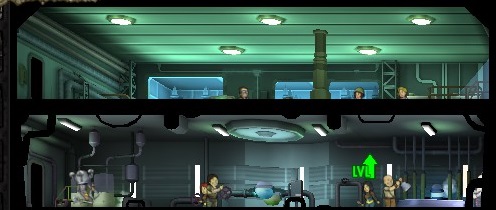
This game has a couple of things the player needs to balance to keep his or her shelter happy and progressing along. In your vault, you have power, food, and water. As you increase your population and rooms in your shelter they would require more rooms and people in them to have enough.
One of the more interesting feelings regarding this was when I was trying to rush to have too big of a population. Managing these three basic resources became quite an issue to the point where I only had people working in these rooms and was unable to do much else. I did not feel like this restraint was in the game to try and get money out of me. I felt it was just a healthy restriction to have. You needed to plan things out before just going for it.
If you did not have enough power some of your rooms would power down and have blackouts. If they were non-essential things like a training room or storage it was not the end of the world. However, if you did not have enough power for water treatment or the dinner that would further compound the issue. Creating further casting issues with workers slowing down and happiness levels dropping.

Keeping true to fallout game S.P.E.C.I.A.L stats on your dwellers can have a big impact. Thankfully the game allowed you if you progressed along enough to start building rooms to train each one of these out. Depending on that dweller it could take or even a day to train a single point. On top of that, you still had to power the room and have food and water for the people training in them.
This created an interesting restraint since you could just not have everyone abounded there rooms to go train up required stats to make them more effective. While you could fully expand out these rooms to hold and train six people at a time at least at the level I was playing that was not wise to do.

I would often shuffle dwellers around and only train in required stats they needed. If I wanted someone to perform better in the Power station, for instance, I would train up there Strength. I would also consider something like Luck to increase their chancing at rushing.
You could also breed your males with the females to help increase the population. Since they had a chance to take on traits of their parents having highly skilled individuals for certain things also became important in trying to grow a very productive vault. Since it was also around a six-hour process for them to have a baby and for it to mature to adulthood. You wanted to only breed higher skilled members you had.
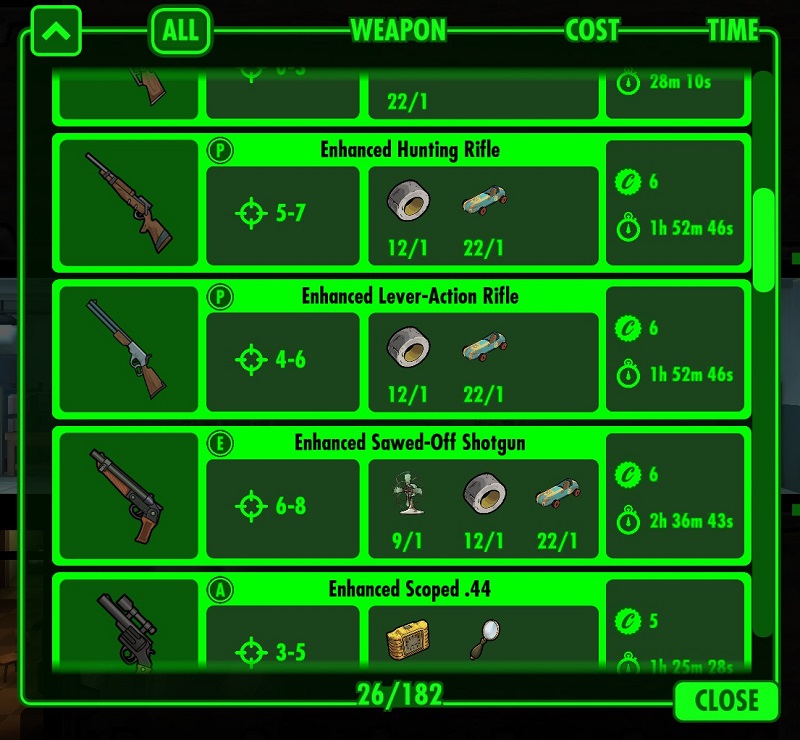
You could also craft consumables like Stimpacks and Radaway to more permanent things like weapons and armor.
Until you started sending your dwellers out to explore the Wasteland the need for these items were quite low. In fact, until your vault hit a certain population you would not even have to worry about raider attacks and if you never upgraded rooms the random events that could happen in them were quite easy to deal with.
Once you started trying to progress you sudden faced needing the ability to heal life and remove radiation from your own members. This meant having enough resources and the manpower to do so without your base struggling to have enough power among other things.
As such you would often have to plan out how you were going move up to the next step or deal with lack of planning on your part. There were quite a few pitfalls like wanting to have these things could do more harm than good.
The crafting rooms themselves for outfits that had stats on them to be able to produce weapons where often times in a limited need. You could find a lot of these things out in the wasteland. In fact, you needed to either break down items or collect the resources from the Wasteland in the first place to craft. You also needed recipes to even craft items in the first place.
It felt like the game gave you the option early on but really you would not see much befits till much later in the game when you had the population to unlock higher tier items. As most times you just had found better until the middle to a late game of crafting. Some of these items also took a few hours to craft unless you wanted to pay a cash shop item to speed things up. This did not seem like a great place to spend money on.

You also had things like storage rooms, living quarters, and Overseer quest room to name a couple. Every couple of population increase there would be a new room unlocked until you hit population 100 and the final room was acquired.
With the way, the population was used to almost gauge your level overall. Since sometimes a requirement to advance a crafting room or able to do more was having a higher population. You always felt like you wanted to get more population as soon as possible. Expect as mention a few times before that was often a poorly plan idea.
It did feel like progression every time you could get a new room. As you progressed you would go from needing a couple of population for increasing, then five, and finally getting a new room every ten. You also had some rooms that replaced there earlier variant of themselves. Such as a Water Purification at 80 dwellers that would replace the water treatment that you started with.
I enjoyed always having something that felt reachable and new that was up and coming to grow my vault out with. It helps keep the game somewhat fresh and to have goals in mind. Often lend me to thinking about how I want to manage my space usage among other things.
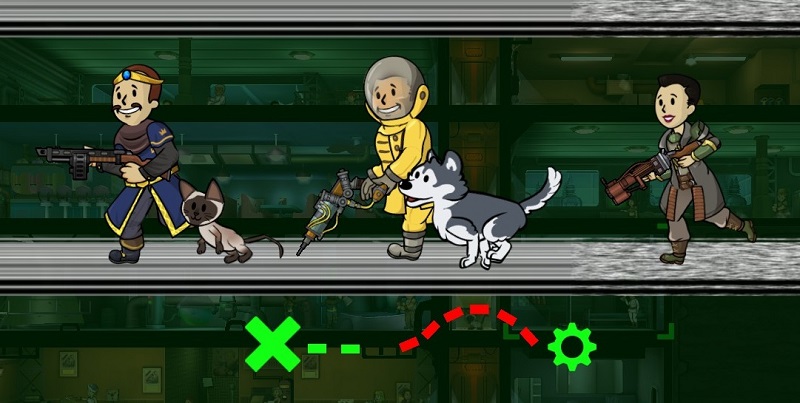
Another part of the game is sending dwellers out to either explore the Wasteland or go on quests. The benefits of doing this were everything from gaining experience to finding some of the most powerful items in the game.

One of your first sense of adventure in this game was sending out a dweller to explore. For the most part, this was just automated. Unless your dweller came across a building you could explore with him. Otherwise, you could just send them out till they got killed, pay to revive them and then send them back home.
This is one of those things you would do and just have real-life time past by without thinking much of it. Your guy could be out for a real life day before he got killed or sooner. You could send them out with stims to heal and hopefully a good weapon and armor as well.
The downside once they found a bunch of caps, weapons, and armor was waiting for them to come back home. While they do take only half as long to return that could be hours or days. You could also pay in Nuka-Cola Quantum which they sold in the cash shop to speed thing s along.
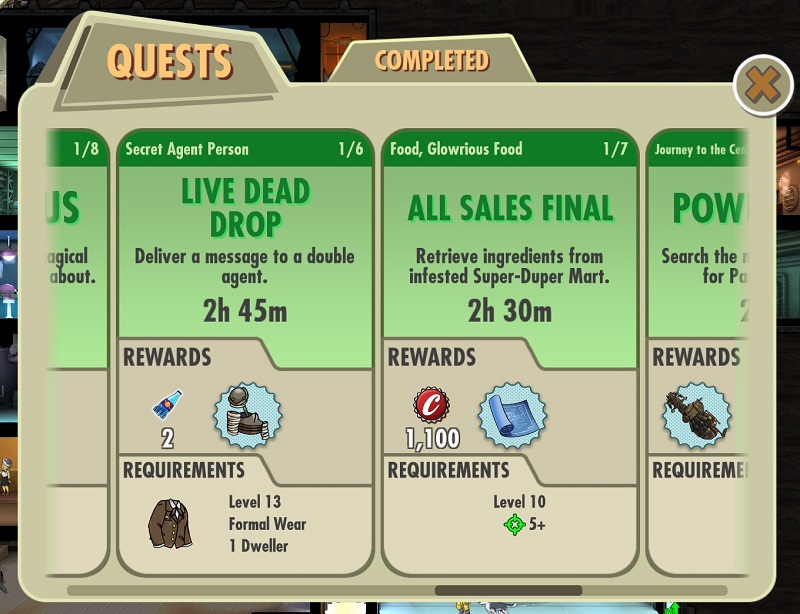
You could also send a team of three dwellers out on quests. This for me was the fun part of the game once they arrived at their emissions. You got to explore a building and fight off raiders to mole rats and so many things in between.
The downside to waiting real life hours to up to a day for your team to arrive at their quest location. Then you also had the return trip back. Some of the travel times just felt like unneeded time gates to get the player to drop some money on Nuka-Cola Quantum.
The quests also had rewards everything from unknown blueprints for crafting to getting Nuka-Cola Quantum. Many times it seems like the game was giving you enough Quantum to instantly return from that quest and go back out on another.

Many of the quests you went on where part of a series where you would have a short story along the five or seven quests. The stories themselves were not very deep at all most of the time. You could go to location A and ask the NPC “where is X,” and they reply, “I think X is at location two.” Go to location two and you get X is at location three and so on until you finally found what you were looking for on the last quest.
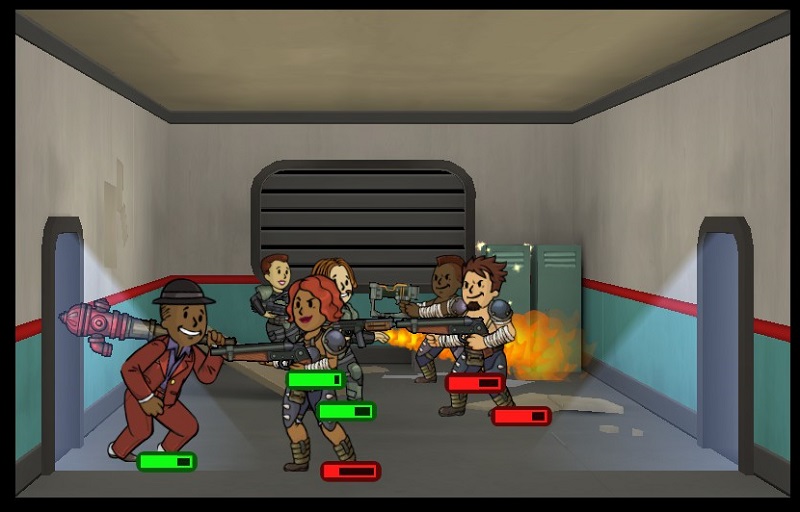
This is also where I noticed just how bad AI in this game. Every room seemed to have a certain placement for everyone to be standing in. Also if you had a dweller with melee weapon once they kill off their target and then just sit around doing nothing. You would have to tell them to attack another monster where they then would have to switch position with whatever dweller that monster was attacking. Which meant both dwellers would have to move and not be attacked during the battle.
During the fights, you would also manage using Stim, Radaway, and any critical attacks that occurred. While sending exploring room by room and picking where to go next. If you failed the quest you could either pay a caps price to try again or take the long walk back home waiting hours to resupply and try again.

This is a single player free to game with a pay to win cash shop. They sell everything from loot boxes (lunchboxes and others) to Nuka-Cola Quantum to speed up the time. Because it is a single player game I felt like if you don’t want to pay. Then it’s not hurting you others are in their own single player games. You can also get rarely free lunchboxes and other items while just playing the game from doing objectives to questing.
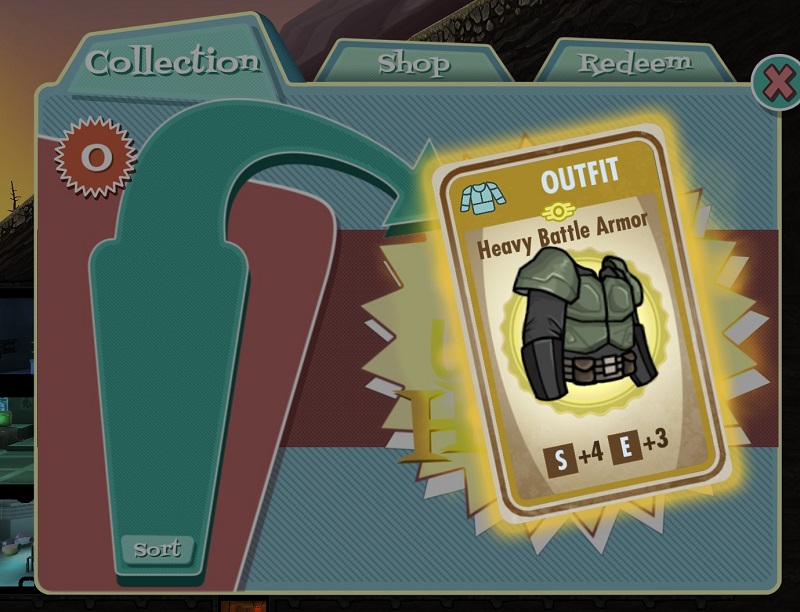
You can also buy a unit called Mr. Handy that collects energy, water, and food instead of you having to click on them to gather. Which does make me wonder if they were not trying to sell him if this would just be automatically done by the game? I have at least had a few tasks where I acquire some of these for free. While they're not required since your vault goes into an inactive like state when you’re not running the game as far as resources go. A giant vault can have dozens of rooms that require you to click to gather from each. He also helps with combat and any things like fires.
They also sell loot boxes for pets that could give you anything from reducing time to return from wasteland to increase the recovery rate. You can only have one pet on each dweller so there are limitations in that respect. This is also something you could get for free from doing objectives.
Then there also the Nuka-Cola Quantum where it feels like the game has quite a few time gates in it to create an opportunity for them to sell these. Each one of these takes up to two hours off a timer.

While the game is not very deep it’s also decent when I’m bored and have ten minutes to kill. One thing they have done is make a version of this game in a few different formats from PC to the smartphone. It’s in quite a few different markets. I wonder how many even know it’s on the PC in the first place. Most think of it as a smartphone game and that is fair as it plays like one.
I do wonder if they sold a version of this game without the cash shop how much more active you could be in it. Clearly that not the business model they went with. It just seemed like a number of unnecessary time gates in the game of waiting around.
I can only hope in the future Bethesda has something a bit more recent worth reviewing. They do have quite an interesting world to build in. I’ve had my fair share of fun over the years. I just hope recent times have woken them up a bit.
Screenshots were taken and content written by @enjar. Screenshots are from a game called Fallout Shelter

